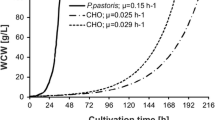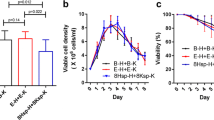Abstract
The efficient production of recombinant proteins such as antibodies typically involves the screening of an extravagant number of clones in order to finally select a stable and high-producing cell line. Thereby, the underlying principles of a powerful protein machinery, but also potential expression limitations, often remain poorly understood. To shed more light on this topic, we applied several different techniques to investigate a previously generated cell line (4B3-IgA), which expressed recombinant immunoglobulin A (IgA) with an unusually low specific productivity. Results were compared to the host cell line and to another recombinant CHO cell line (3D6-IgA) expressing another IgA that binds to an overlapping epitope. The low specific productivity of clone 4B3-IgA could not be explained by GCN or mRNA levels, but insufficiencies in protein maturation and/or secretion were determined. Despite the presence of free light chain polypeptides, they occasionally failed to associate with their heavy chain partners. Consequently, heavy chains were misassembled and accumulated to form intracellular aggregates, so-called Russell bodies. These protein deposits evoked the expression of increased amounts of ER-resident chaperones to combat the induced stress. Despite bottlenecks in protein processing, the cells’ quality checkpoints remained intact, and predominantly correctly processed IgA was exported into the culture medium. The results of our study demonstrated that recombinant protein expression was impaired by heavy chain aggregation despite the presence of a disposable light chain and revealed elevated chaperone formation in combination with limited antibody assembly. Our studies suggest that the primary amino acid sequence and consequently the resulting structure of an expressed protein need to be considered as a factor influencing a cell’s productivity.





Similar content being viewed by others
References
Bibila TA, Flickinger MC (1992) Use of a structured kinetic model of antibody synthesis and secretion for optimization of antibody production systems: I. Steady-state analysis. Biotechnol Bioeng 39:251–261
Borth N, Strutzenberger K, Kunert R, Steinfellner W, Katinger H (1999) Analysis of changes during subclone development and ageing of human antibody-producing heterohybridoma cells by northern blot and flow cytometry. J Biotechnol 67:57–66
Borth N, Mattanovich D, Kunert R, Katinger H (2005) Effect of increased expression of protein disulfide isomerase and heavy chain binding protein on antibody secretion in a recombinant CHO cell line. Biotechnol Prog 21:106–111
Chusainow J, Yang YS, Yeo JH, Toh PC, Asvadi P, Wong NS, Yap MG (2009) A study of monoclonal antibody-producing CHO cell lines: what makes a stable high producer? Biotechnol Bioeng 102:1182–1196
Corcos D, Osborn MJ, Matheson LS, Santos F, Zou X, Smith JA, Morgan G, Hutchings A, Hamon M, Oxley D, Brüggemann M (2010) Immunoglobulin aggregation leading to Russell body formation is prevented by the antibody light chain. Blood 115:282–288
Ellgaard L, Helenius A (2003) Quality control in the endoplasmic reticulum. Nat Rev Mol Cell Biol 4:181–191
Honegger A (2008) Engineering antibodies for stability and efficient folding. Handb Exp Pharmacol 47–68
Jayapal KP, Wlaschin KF, Yap MGS, Hu WS (2007) Recombinant protein therapeutics from CHO cells - 20 years and counting. Chem Eng Prog 103:40–47
Jiang Z, Huang Y, Sharfstein ST (2006) Regulation of recombinant monoclonal antibody production in Chinese hamster ovary cells: a comparative study of gene copy number, mRNA level, and protein expression. Biotechnol Prog 22:313–318
Kopito RR, Sitia R (2000) Aggresomes and Russell bodies. Symptoms of cellular indigestion? EMBO Rep 1:225–231
Lattenmayer C, Trummer E, Schriebl K, Vorauer-Uhl K, Mueller D, Katinger H, Kunert R (2007) Characterisation of recombinant CHO cell lines by investigation of protein productivities and genetic parameters. J Biotechnol 128:716–725
Lee YK, Brewer JW, Hellman R, Hendershot LM (1999) BiP and immunoglobulin light chain cooperate to control the folding of heavy chain and ensure the fidelity of immunoglobulin assembly. Mol Biol Cell 10:2209–2219
Mohan C, Kim YG, Koo J, Lee GM (2008) Assessment of cell engineering strategies for improved therapeutic protein production in CHO cells. Biotechnol J 3:624–630
Peressin M, Holl V, Schmidt S, Decoville T, Mirisky D, Lederle A, Delaporte M, Xu K, Aubertin AM, Moog C (2011) HIV-1 replication in Langerhans and interstitial dendritic cells is inhibited by neutralizing and Fc-mediated inhibitory antibodies. J Virol 85:1077–1085
Reinhart D, Weik R, Kunert R (2012) Recombinant IgA production: single step affinity purification using camelid ligands and product characterization. J Immunol Methods 378:95–101
Reinhart D, Sommeregger W, Debreczeny M, Gludovacz E, Kunert R (2013) Characterization of recombinant IgA producing CHO cell lines by qPCR. BMC Proc 7(Suppl 6):P114
Reisinger H, Steinfellner W, Stern B, Katinger H, Kunert R (2008) The absence of effect of gene copy number and mRNA level on the amount of mAb secretion from mammalian cells. Appl Microbiol Biotechnol 81:701–710
Schröder M, Körner C, Friedl P (1999) Quantitative analysis of transcription and translation in gene amplified Chinese hamster ovary cells on the basis of a kinetic model. Cytotechnology 29:93–102
Stoops J, Byrd S, Hasegawa H (2012) Russell body inducing threshold depends on the variable domain sequences of individual human IgG clones and the cellular protein homeostasis. Biochim Biophys Acta 1823:1643–1657
Strutzenberger K, Borth N, Kunert R, Steinfellner W, Katinger H (1999) Changes during subclone development and ageing of human antibody-producing recombinant CHO cells. J Biotechnol 69:215–226
Tiller T, Schuster I, Deppe D, Siegers K, Strohner R, Herrmann T, Berenguer M, Poujol D, Stehle J, Stark Y, Heßling M, Daubert D, Felderer K, Kaden S, Kölln J, Enzelberger M, Urlinger S (2013) A fully synthetic human Fab antibody library based on fixed VH/VL framework pairings with favorable biophysical properties. MAbs 5
Urlaub G, Chasin LA (1980) Isolation of Chinese hamster cell mutants deficient in dihydrofolate reductase activity. Proc Natl Acad Sci U S A 77:4216–4220
Weclewicz K, Svensson L, Kristensson K (1998) Targeting of endoplasmic reticulum-associated proteins to axons and dendrites in rotavirus-infected neurons. Brain Res Bull 46:353–360
Xiao G, Chung TF, Pyun HY, Fine RE, Johnson RJ (1999) KDEL proteins are found on the surface of NG108-15 cells. Brain Res Mol Brain Res 72:121–128
Acknowledgements
This study was funded by the European Community’s Seventh Framework Programme (FP7/2002-2013) under grant agreement no. 201038, EuroNeut-41, and sponsored by Polymun Scientific Immunbiologische Forschung GmbH, Donaustraße 99, 3400 Klosterneuburg, Austria.
Conflict of interest
The authors have declared no conflict of interest.
Author information
Authors and Affiliations
Corresponding author
Rights and permissions
About this article
Cite this article
Reinhart, D., Sommeregger, W., Debreczeny, M. et al. In search of expression bottlenecks in recombinant CHO cell lines—a case study. Appl Microbiol Biotechnol 98, 5959–5965 (2014). https://doi.org/10.1007/s00253-014-5584-z
Received:
Revised:
Accepted:
Published:
Issue Date:
DOI: https://doi.org/10.1007/s00253-014-5584-z




